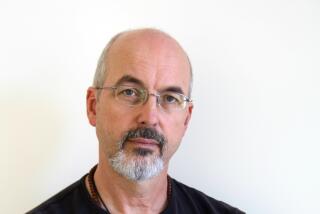From art house to slaughterhouse
- Share via
VIENNA — A naked man is lashed to a large wooden crucifix and slathered in the blood of a freshly slaughtered bull. A canvas is smeared with crimson oil paint and pig entrails that glisten sickeningly beneath a spotlight.
This is the grotesque world of Hermann Nitsch, a self-proclaimed “ritual artist” whose bizarre works are drawing large crowds -- and allegations of blasphemy and animal cruelty.
A retrospective of his work, on view through Jan. 11 at suburban Vienna’s prestigious Sammlung Essl gallery of contemporary art, certainly provokes: It can trigger puzzlement, anger and nausea, depending on one’s constitution and sensibilities. And it is not the sort of exhibition that inspires visitors to snap up show catalogs for their coffee tables or order roast-beef sandwiches in the museum cafe.
To the somber beat of drums and Gregorian chants, Nitsch -- whose works have hung in New York’s Guggenheim Museum and the Metropolitan Museum of Art, and London’s Tate Gallery -- revels in what many see as orgies of paganism.
“Art behaving badly,” a British critic once said.
Although his signature works are abstract paintings created by sponging animal blood onto large white canvases, letting it dry to earth tones and then applying splatters and drips of bright red oils, Nitsch (pronounced “neech”) has unleashed controversy with what he calls “actions.”
His most recent was in mid-November, when two dozen actors -- some clad in white smocks and blindfolds, others wearing nothing at all -- waited patiently as butchers supervised by a veterinarian slaughtered and disemboweled a steer, and then plunged with abandon into the bloody pulp.
Nitsch, 65, has organized 115 of these fleshfests to enthusiastic, sellout crowds since he first startled the art world in the mid-1960s by adding blood and entrails to his palette. His “actions,” usually performed in the courtyard of his sprawling country estate in Prinzendorf, in the picturesque wine country 50 miles north of Vienna, are not for the fainthearted.
The bloodletting and splattering can last for days, involving nude actors who are mock-crucified and have clusters of cow intestines, pancreases and other organs arranged on their bodies to a cacophony of drums, trumpets, saxophones and electronic music.
The most disturbing images in the Essl show, in which Nitsch’s abstract paintings are interspersed with hundreds of photographs and hours of videotape from past “actions,” depict live actors with animal carcasses split wide and stretched over their own bodies.
At first glance -- and a quick glance is all that many viewers can bear -- the scenes look as though a human being has been sadistically gutted by a serial killer and dutifully captured by a coroner’s camera. The latest show is not scheduled to travel beyond Austria.
“Nitsch is a great tragedian,” said Andrea Cusumano, an Italian multimedia painter and sculptor. “Like thunder, it hammers through the fuzzy noises of our everyday concerns and can stimulate even the most lethargic of minds,” he said of Nitsch’s work.
But is it art?
Stocky and bespectacled, the bushy-bearded Nitsch -- who frequently speaks of “a sense of sacred solemnity” -- insists that it is.
“I am everything at once: painter, poet, theater maker, musician, lyricist and sculptor,” he says. “I think that art as such is absolutely free, especially in terms of how the artist chooses to realize it.... The splendor and colorfulness of death corresponds to the colorfulness of life.”
Nitsch’s many critics are repulsed.
Although displays of his paintings outside of Austria have met with little opposition, word of the Austria bloodbaths has even reached the U.S. Congress. In 1998, Rep. James Traficant (D-Ohio) criticized Nitsch’s work as “out of control.”
Some scandalized Austrian politicians are calling on the government to make sure it doesn’t subsidize his works or purchase any for national museums. In 1999, the state spent $60,000 to acquire paintings by Nitsch.
“Whoever does this kind of thing doesn’t need promotion -- he needs a doctor,” Gottfried Waldhaeusl, a regional lawmaker, recently told the Die Presse newspaper.
Born in Vienna in 1938, Nitsch studied at Austria’s School of Graphic Design and Photography, where he developed a keen interest in art, literature and philosophy.
After graduation, he became an assistant at the Technical Museum of Vienna, where he performed his first “action” in 1957 and wrote the 1,595-page script for the bloody performances he later dubbed “Orgy Mystery Theater.”
Police stopped Nitsch’s first performance in 1962, prompting the artist and his entourage to flee and toss the carcass of a sheep into the Danube River. They were jailed for three days.
Brigitte Bardot, the French actress and animal rights activist, came to Austria in 1998 to urge a boycott of a six-day Nitsch extravaganza involving the slaughter of three bulls. “I have never heard of a performance where people pay to rejoice in the suffering of animals,” she said at the time.
Nitsch’s persistent inclusion of crosses, chalices and other religious imagery in his work has also prompted cries of blasphemy from Austria’s Roman Catholic bishops.
The artist deflects such criticism, describing himself as deeply spiritual and -- oddly enough -- as an animal lover.
“I need to hear the peacock scream and the cock crow when I wake up in the morning,” he says. “I’m very happy when I am surrounded by my animals.”
More to Read
The biggest entertainment stories
Get our big stories about Hollywood, film, television, music, arts, culture and more right in your inbox as soon as they publish.
You may occasionally receive promotional content from the Los Angeles Times.










